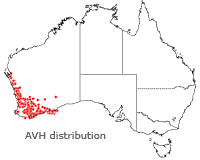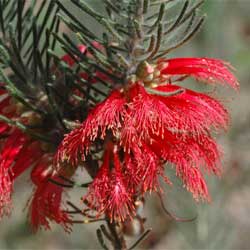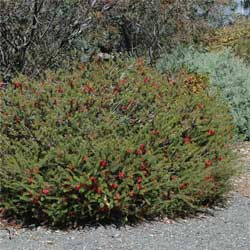Calothamnus quadrifidus
One-sided Bottlebrush, Common Net Bush
 Calothamnus quadrifidus naturally occurs in the south-west region of Western Australia where it is widely distributed. It is a member of the Myrtaceae family with its closest relatives being Beaufortia, Eremaea and Regelia. Also known as Common Net Bush or One-sided Bottlebrush it is an excellent plant to grow in Australian gardens. The beautiful flowers produced over a long period are noticeably bird attracting and the lovely texture of the foliage provides a pleasing contrast in the garden. Calothamnus quadrifidus can be grown to create an effective screen and/or windbreak.
Calothamnus quadrifidus naturally occurs in the south-west region of Western Australia where it is widely distributed. It is a member of the Myrtaceae family with its closest relatives being Beaufortia, Eremaea and Regelia. Also known as Common Net Bush or One-sided Bottlebrush it is an excellent plant to grow in Australian gardens. The beautiful flowers produced over a long period are noticeably bird attracting and the lovely texture of the foliage provides a pleasing contrast in the garden. Calothamnus quadrifidus can be grown to create an effective screen and/or windbreak.
C. quadrifidus is an upright, compact or spreading, heavily-branched, evergreen shrub that grows to about 1.5 – 2.5 metres tall and a similar width. The grey-green or green needle-like leaves are about 30 mm long and 1-2 mm wide and are usually hairy giving the foliage a lovely soft appearance.
The showy flowers, clustered in one-sided spikes, are produced through all of spring and well into summer, and sometimes spanning a longer period. The brightly coloured stamens, usually in red, are the conspicuous parts of the flower and are fused together in bundles, known as staminal claws. The fruits produced are woody capsules that remain on the plant throughout its life and can contain seeds for many years.
C. quadrifidus is very adaptable to a range of environmental and growing conditions and is considered moderately hardy, tolerating windy and coastal situations. It grows naturally in a dry summer climate but will also grow in somewhat more humid conditions. C. quadrifidus is not too fussy and copes with conditions ranging from the soil becoming dry between watering to being constantly moist (but not constantly wet). It commonly grows naturally among granite outcrops, in sand or sandy-gravel, however it adapts well to other soil types such as loam, and even clay. A neutral to mildly alkaline soil is probably best, though it is known to grow also in mildly acidic soil. Whatever the soil type, better drainage will improve results.
Young plants can be somewhat frost sensitive, however established plants will tolerate frosts with perhaps only minimal tip damage. C. quadrifidus grows well in either full sun or part shade, though it favours a warm, open and sunny position, and while not being a heavy feeder, it will perform best if provided with regular additions of compost and/or the occasional application of a ‘complete’ or balanced fertiliser. Avoid over-fertilising.
Regular pruning (in conjunction with adequate nutrition) will keep this plant dense and growing vigorously. With age it can become rather woody and “leggy” if left unattended. C. quadrifidus will happily tolerate removal of up to one third of the foliage, which is best done just after flowering. Hard pruning into old wood may affect the next season’s flowering, as the flowers are borne on stems of the previous season’s growth.
C. quadrifidus is not prone to disease or attack from many pests. Scale insects can be managed by good horticultural practice such as regular pruning and adequate nutrition to keep growth vigorous, and positioning plants with good airflow. It is always best to regularly inspect plants and prune out any affected branches before populations of scale are allowed to build up.
C. quadrifidus reproduces readily by seed and ‘ripe’ fruits can be collected in paper bags and placed in warm conditions (~30°C) to release the seed, for later sowing in autumn or early spring. Softwood or tip cuttings taken in late summer are recommended if you want to propagate a particular form.
C. quadrifidus has a number of subspecies and cultivars include yellow-flowered, dwarf, and grey-green foliaged forms.
Text by Carol Booth (2011 Student Botanical Intern)
Name Meaning: Calothamnus quadrifidusCalothamnus – derived from the ancient Greek kalos, meaning “beautiful” and thamnos meaning “a shrub”. quadrifidus – meaning “divided into four parts” referring to the floral structure. |
References
Archer, W. (2009) One-sided Bottlebrush – Calothamnus quadrifidus subsp. quadrifidus, Esperance Wildflowers. Available at http://esperancewildflowers.blogspot.com/2009/03/one-sided-bottlebrush-calothamnus.html [Accessed February 2011]
Australian Native Plants Society ( Australia) (2007) Calothamnus quadrifidus. Available at http://anpsa.org.au/c-qua.html [Accessed February 2011]
Clarke, G. et al. (2001) Australian Plants for Canberra Region Gardens, 4th edn, Society for Growing Australian Plants Canberra Region Inc., ACT.
Fairall, A.R. (1970) West Australian Native Plants in Cultivation, Pergamon Press Ltd, NSW.
Flora’s Native Plants (2004) ABC Gardening Australia, NSW.
FloraBase: the Western Australian Flora . Calothamnus quadrifidus. Descriptions by the Western Australian Herbarium, Department of Environment and Conservation. Text used with permission. Available at http://florabase.calm.wa.gov.au. [Accessed on February 2011]
Wrigley, J.W. & Fagg, M. (2003) Australian Native Plants, 5th edn, Reed New Holland, Sydney.
Wrigley, J.W. & Fagg, M. (1993) Bottlebrushes, paperbarks and tea trees, and all other species in the Leptospermum alliance, Angus & Robertson Publishers, NSW.
Wrigley, J.W. & Fagg, M. (1990) Bird Attracting Plants, Angus & Robertson Publishers, NSW
![An Australian Government Initiative [logo]](/images/austgovt_brown_90px.gif)



